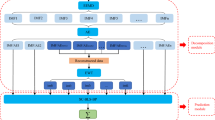Abstract
This paper aims to develop a load forecasting method for short-term load forecasting based on multiwavelet transform and multiple neural networks. Firstly, a variable weight combination load forecasting model for power load is proposed and discussed. Secondly, the training data are extracted from power load data through multiwavelet transform. Lastly, the obtained data are trained through a variable weight combination model. BP network, RBF network and wavelet neural network are adopted as the training network, and the trained data from three neural networks are input to a three-layer feedforward neural network for the load forecasting. Simulation results show that accuracy of the combination load forecasting model proposed in the paper is higher than any one single network model and the combination forecast model of three neural networks without preprocessing method of multiwavelet transform.




Similar content being viewed by others
References
Hippert HS, Pedreira CE, Castro R (2001) Neural networks for short term load forecasting: a review and evaluation. IEEE Trans Power Syst 16(1):44–55
Haida T, Muto S (1994) Regression based peak load forecasting using a transformation technique. IEEE Trans Power Syst 9(4):1788–1794
Papalexopoulos AD, Hesterberg TC (1990) A regression-based approach to short-term load forecasting. IEEE Trans Power Syst 5(4):1535–1550
Rahman S, Hazim O (1993) A generalized knowledge-based short term load-forecasting technique. IEEE Trans Power Syst 8(2):508–514
Huang SJ, Shih KR (2003) Short-term load forecasting via ARMA model identification including non-Gaussian process considerations. IEEE Trans Power Syst 18(2):673–679
Infield DG, Hill DC (1998) Optimal smoothing for trend removal in short term electricity demand forecasting. IEEE Trans Power Syst 13(3):1115–1120
Peng TM (1993) An adaptive neural network approach to one-week ahead forecasting. IEEE Trans Power Syst 8(3):1195–1203
Khotanzad A, Hwang RC, Abaye A, Maratukulam D (1995) An adaptive modular artificial neural network hourly load forecaster and its implementation at electric utilities. IEEE Trans Power Syst 10(3):1716–1722
Saini LM, Soni MK (2002) Artificial neural network-based peak load forecasting using conjugate gradient methods. IEEE Trans Power Syst 12(3):907–912
Kim KH (2000) Short-term load forecasting for special days in anomalous load conditions using neural networks and fuzzy inference method. IEEE Trans Power Syst 15(2):559–565
Liao GC, Tsao TP (2006) Application of a fuzzy neural network combined with a chaos genetic algorithm and simulated annealing to short-term load forecasting. IEEE Trans Evol Comput 10(3):330–340
Zhang GP, Patuwo EB, Hu MY (2001) A simulation study of artificial neural networks for nonlinear time-series forecasting. Comput Oper Res 28:381–396
James WT, Derek WB (1999) Investigating improvements in the accuracy of prediction intervals for combinations of forecasts: a simulation study. Int J Forecast 15(3):325–339
Xie KG, Li CY, Zhou JQ (2002) Research of the combination forecasting model for load based on artificial neural network. Proc CSEE 22(7):85–89
Jacobs R, Jordan M, Nowlan S, Hinton GE (1991) Adaptive mixture of local experts. Neural Comput 3:79–87
Shi S M, Liu B (1993) Nonlinear combination of forecasts with neural networks. Proceedings of international joint conference on neural networks, Nagoya, 25–29 Oct 1:959–962
Aleksejs Zorins (2003) Nonlinear combination of forecasts with neural networks. In: Proceedings of international conference information society and modern business, Ventspils, Latvia, January 31–February 1
Liu Y, Yao X (1999) Simultaneous training of negatively correlated neural networks in an ensemble. IEEE Trans Syst Man Cybern. Part B, 29(6):716–725
Khotanzad A, Elragal H, Lu TL (2000) Combination of artificial neural-network forecasters for prediction of natural gas consumption. IEEE Trans Neural Netw 11(2):1045–9227
Ginzburg I, Horn D (1994) Combined neural networks for time series analysis. Neural Inf Process Syst 6:224–231
Alpert BK, Rokhin V (1991) A fast algorithm for the evaluation of Legendre expansion. SIAM J Sci Stat Comput 12:158–179
Goodman TNT, Lee SL (1994) Wavelets of multiplicity r. Trans Am Math Soc 342:307–324
Geronimo JS, Hardin DP, Massopust PR (1996) Construction of orthogonal wavelets using fractal interpolation functions. SIAM J Math Anal 27:1158–1192
Chui CK, Lian JA (1996) A study of orthonormal multi-wavelets. Appl Numer Math 20:273–298
Bashir Z, El-Hawary ME (2000) Short term load forecasting by using wavelet neural networks. Can Conf Electr Comput Eng 1:163–166
Cotronei M, Montefusco LB, Puccio L (1998) Multiwavelet analysis and signal processing. IEEE Trans Circuits Syst II: Analog Digit Signal Process 45(8):970–987
Liang HF, Tu GY, Tang HW (2001) Application of genetic algorithm neural network for short term load forecasting of power system. Power Syst Technol 25(1):49–53
Acknowledgments
This study was supported by National Nature Science Foundation of China (No. 51007074), New Century Excellent Talents Project Fund (NECT-08-0825), Fok Ying Tung Education Fund (No. 101060), Sichuan Province Distinguished Scholars Fund (No. 07ZQ026-012) and Fundamental Research Funds for the Central Universities (No. SWJTU09ZT10) in China.
Author information
Authors and Affiliations
Corresponding author
Rights and permissions
About this article
Cite this article
Liu, Z., Li, W. & Sun, W. A novel method of short-term load forecasting based on multiwavelet transform and multiple neural networks. Neural Comput & Applic 22, 271–277 (2013). https://doi.org/10.1007/s00521-011-0715-2
Received:
Accepted:
Published:
Issue Date:
DOI: https://doi.org/10.1007/s00521-011-0715-2




